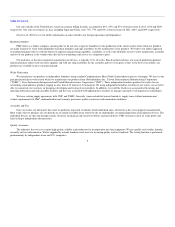Adaptec 2011 Annual Report Download - page 17
Download and view the complete annual report
Please find page 17 of the 2011 Adaptec annual report below. You can navigate through the pages in the report by either clicking on the pages listed below, or by using the keyword search tool below to find specific information within the annual report.
Table of Contents
We regularly limit our exposure to foreign exchange rate fluctuations from our foreign net asset or liability positions. We recorded a net $0.5 million
foreign exchange gain on the revaluation of our income tax liability in 2011 because of the fluctuations in the U.S. dollar against certain foreign currencies. A
five percent shift in the foreign exchange rates between the U.S. and Canadian dollar would cause an approximately $2.9 million impact to our pre-tax net
income.
We are exposed to the credit risk of some of our customers.
Many of our customers employ contract manufacturers to produce their products and manage their inventories. Many of these contract manufacturers
represent greater credit risk than our OEM customers, who do not guarantee our credit receivables related to their contract manufacturers.
In addition, a significant portion of our sales flow through our distribution channel, this generally represents a higher credit risk. Should these
companies encounter financial difficulties, our revenues could decrease, and collection of our significant accounts receivables with these companies or other
customers could be jeopardized.
Our business strategy contemplates acquisition of other products, technologies or businesses, which could adversely affect our operating
performance.
Acquiring products, intellectual property, technologies and businesses from third parties is a core part of our business strategy. That strategy depends on
the availability of suitable acquisition candidates at reasonable prices and our ability to resolve challenges associated with integrating acquired businesses into
our existing business. These challenges include integration of product lines, sales forces, customer lists and manufacturing facilities, development of expertise
outside our existing business, diversion of management time and resources, possible divestitures, inventory write-offs and other charges. We also may be
forced to replace key personnel who may leave our company as a result of an acquisition. We cannot be certain that we will find suitable acquisition
candidates or that we will be able to meet these challenges successfully. Acquisitions could also result in customer dissatisfaction, performance problems with
the acquired company, investment, or technology, the assumption of contingent liabilities, or other unanticipated events or circumstances, any of which could
harm our business. Consequently, we might not be successful in integrating any acquired businesses, products or technologies and may not achieve
anticipated revenues and cost benefits.
An acquisition could absorb substantial cash resources, require us to incur or assume debt obligations, or issue additional equity. If we are not able to
obtain financing, then we may not be in a position to consummate acquisitions. If we issue equity securities in connection with an acquisition, we may dilute
our common stock with securities that have an equal or a senior interest in our company.
From time to time, we license, or acquire, technology from third parties to incorporate into our products. Incorporating technology into our
products may be more costly or more difficult than expected, or require additional management attention to achieve the desired functionality. The
complexity of our products could result in unforeseen or undetected defects or bugs, which could adversely affect the market acceptance of new
products and damage our reputation with current or prospective customers.
Our current product roadmap will, in part, be dependent on successful acquisition and integration of intellectual property cores developed by third
parties. If we experience difficulties in obtaining or integrating intellectual property from these third parties, it could delay or prevent the development of our
products in the future.
Although our customers, our suppliers and we rigorously test our products, our highly complex products may contain defects or bugs. We have in the
past experienced, and may in the future experience, defects and bugs in our products. If any of our products contain defects or bugs, or have reliability, quality
or compatibility problems that are significant to our customers, our reputation may be damaged and customers may be reluctant to
16
























